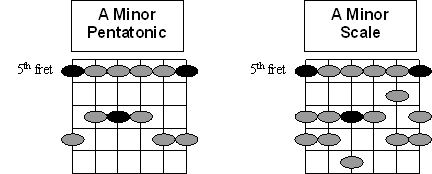It’s a common scenario.
You’ve been playing guitar for a while…
You’re getting comfortable creating your own guitar solos with pentatonic scales. Actually, you might be getting a bit too comfortable using the pentatonic scales for soloing. You’re starting to find your guitar solos becoming more and more boring.
You’re looking for more.
You’re looking for a better sound.
What do you do?
At this point most guitarists turn to the major and minor scales.
The problem is the transition. Most guitar players have a hard time adding the major and minor scales to their guitar soloing arsenal.
Today we will look at the first step to adding major and minor scales into your soloing.
The first thing you need to understand is that the pentatonic scale is simply a five-note scale. There are actually many different types of pentatonic scales. But for most guitar players, when they talk about pentatonic scales they are referring to the major and/or minor pentatonic scale.
Our focus right now will be on the minor pentatonic scale.
The A minor pentatonic scale consists of the following notes:
A C D E G
Here is the most common fingering for A minor pentatonic:
Now let’s look at the minor scale. The A minor scale consists of the following notes:
A B C D E F G
This is a seven-note scale.
Here is a fingering for the A minor scale:
What do you notice when you compare these two scales?
Did you notice that they share some of the same notes?
If you were to drop out the notes B and F from the minor scale, you will have an A minor pentatonic scale.
The best way to start using the minor scale in your guitar solos is to first think of it as simply giving you some extra notes to add into your guitar solos.
Your first step is to make sure you are familiar with both of the scale fingerings shown above. Make sure you have each scale form memorized. Then you can start to mix things up a bit.
Exercise #1
Play the minor pentatonic scale ascending and then play the minor scale descending. Do this several times until you feel comfortable doing this.
Exercise #2
Next play the minor scale ascending and play the minor pentatonic scale descending. Practice this until you can easily play it.
Exercise #3
Finally, play the minor scale ascending and descending, and then play the minor pentatonic scale ascending and descending.
Once you’ve completed the above exercises you are ready to start to experiment with these scales in your guitar solos.
There are two main approaches I would recommend at first.
The first way to begin soloing is to make the minor pentatonic scale your main scale. All you do is add in the extra two notes here and there for extra interest.
Once you feel comfortable with the above you can switch it up. Now start soloing with the minor scale as you main scale and simply drop out the notes B and F occasionally. This means you will now be primarily using the minor scale for your guitar solos!
As you can guess, there’s lots more to soloing than this, but this will get you well on your way to creating cool-sounding guitar solos.
To learn more fingerings for the minor scale and see how they connect over the entire fretboard check out my guitar scale resource called The World of Scales: A Compendium of Scales for the Modern Guitar Player.
















